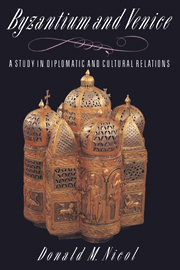Book contents
- Frontmatter
- Contents
- Dedication
- Preface
- List of abbreviations
- Maps of the Byzantine and Venetian worlds
- 1 Venice: the Byzantine province
- 2 Venice: the Byzantine protectorate
- 3 Venice: the ally of Byzantium
- 4 Venice: the partner of Byzantium
- 5 Byzantium, Venice and the First Crusade
- 6 The parting of the ways
- 7 The calm before the storm
- 8 The Fourth Crusade
- 9 Venice in Byzantium: the Empire of Romania
- 10 Venice: champion of a lost cause
- 11 Byzantium, Venice and the Angevin threat
- 12 Byzantium, Venice and Genoa
- 13 Conflicting interests and competing claims
- 14 Byzantium, Venice and the Turks
- 15 Byzantium: the victim of commercial rivalry
- 16 The profit and honour of Venice
- 17 Jewels for an island
- 18 Byzantium in thrall to the Turks and in debt to Venice
- 19 Byzantine optimism and Venetian vacillation
- 20 Byzantium the suppliant of Venice
- 21 The worst news for all of Christendom: Venice and the fall of Constantinople
- 22 Legacies and debts
- Byzantine Emperors
- Doges of Venice
- Bibliography
- Index
3 - Venice: the ally of Byzantium
Published online by Cambridge University Press: 01 April 2010
- Frontmatter
- Contents
- Dedication
- Preface
- List of abbreviations
- Maps of the Byzantine and Venetian worlds
- 1 Venice: the Byzantine province
- 2 Venice: the Byzantine protectorate
- 3 Venice: the ally of Byzantium
- 4 Venice: the partner of Byzantium
- 5 Byzantium, Venice and the First Crusade
- 6 The parting of the ways
- 7 The calm before the storm
- 8 The Fourth Crusade
- 9 Venice in Byzantium: the Empire of Romania
- 10 Venice: champion of a lost cause
- 11 Byzantium, Venice and the Angevin threat
- 12 Byzantium, Venice and Genoa
- 13 Conflicting interests and competing claims
- 14 Byzantium, Venice and the Turks
- 15 Byzantium: the victim of commercial rivalry
- 16 The profit and honour of Venice
- 17 Jewels for an island
- 18 Byzantium in thrall to the Turks and in debt to Venice
- 19 Byzantine optimism and Venetian vacillation
- 20 Byzantium the suppliant of Venice
- 21 The worst news for all of Christendom: Venice and the fall of Constantinople
- 22 Legacies and debts
- Byzantine Emperors
- Doges of Venice
- Bibliography
- Index
Summary
The growing population and the rising prosperity of the city on the Rialto brought a recurrence of the family feuds and jealousies that had bedevilled the original settlements of refugees in the other islands. Pietro Tradonico had done much to keep the peace between the rival factions for more than twenty years. But at the last he fell victim to a conspiracy. He was murdered outside the church of St Zaccaria in September 864. His successor, Orso I Partecipazio (or Badoer), was appointed only after days of fighting in the streets and mainly because he was thought to be a neutral party in all the sordid squabbles. It was with Orso that Basil I exchanged courtesies in 879 and it was he who secured the freedom of Venice from the Franks in 880. No less important for the future of his city were the constitutional reforms that he introduced. Venice was supposed to be governed by its people and their elected representatives as a democracy, a form of government which the Byzantines, for all their classical heritage, despised. In practice, however, the power of the Doge had become more and more absolute. The administration, the domestic and foreign policy were controlled by him and by the faction which had put him up; the authority of the tribunes appointed to curb his power had declined; and the practice of co-option of his sons had come near to creating a hereditary monarchy. Orso invented a new curb on his own authority and that of his followers by the institution of judges (judices) elected to be magistrates as well as counsellors to the Doge.
- Type
- Chapter
- Information
- Byzantium and VeniceA Study in Diplomatic and Cultural Relations, pp. 35 - 49Publisher: Cambridge University PressPrint publication year: 1989



